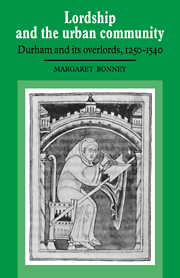Book contents
- Frontmatter
- Contents
- Acknowledgements
- List of abbreviations
- INTRODUCTION
- 1 URBAN ORIGINS: THE GROWTH AND DEVELOPMENT OF DURHAM TO 1250
- 2 THE URBAN LANDSCAPE OF DURHAM 1250–1540
- 3 DURHAM'S MEDIEVAL BUILDINGS
- 4 LANDLORD AND TENANTS: THE ECONOMIC RELATIONSHIP BETWEEN DURHAM PRIORY AND ITS URBAN TENANTS IN THE LATER MIDDLE AGES
- 5 TRADES AND OCCUPATIONS
- 6 LORDSHIP IN ACTION: THE MAINTENANCE OF LAW AND ORDER IN LATE-MEDIEVAL DURHAM
- CONCLUSION: LORDSHIP AND COMMUNITY: THE RELATIONS BETWEEN DURHAM AND ITS ECCLESIASTICAL OVERLORDS IN THE LATER MIDDLE AGES
- Appendix 1 Maps and plans of Durham
- Appendix 2 Tables
- Appendix 3 The dates of the bishops of Durham from 995 to the Dissolution
- Appendix 4 The obedientiaries of Durham Priory
- Appendix 5 The Durham courts
- Bibliography
- Index
3 - DURHAM'S MEDIEVAL BUILDINGS
Published online by Cambridge University Press: 06 January 2010
- Frontmatter
- Contents
- Acknowledgements
- List of abbreviations
- INTRODUCTION
- 1 URBAN ORIGINS: THE GROWTH AND DEVELOPMENT OF DURHAM TO 1250
- 2 THE URBAN LANDSCAPE OF DURHAM 1250–1540
- 3 DURHAM'S MEDIEVAL BUILDINGS
- 4 LANDLORD AND TENANTS: THE ECONOMIC RELATIONSHIP BETWEEN DURHAM PRIORY AND ITS URBAN TENANTS IN THE LATER MIDDLE AGES
- 5 TRADES AND OCCUPATIONS
- 6 LORDSHIP IN ACTION: THE MAINTENANCE OF LAW AND ORDER IN LATE-MEDIEVAL DURHAM
- CONCLUSION: LORDSHIP AND COMMUNITY: THE RELATIONS BETWEEN DURHAM AND ITS ECCLESIASTICAL OVERLORDS IN THE LATER MIDDLE AGES
- Appendix 1 Maps and plans of Durham
- Appendix 2 Tables
- Appendix 3 The dates of the bishops of Durham from 995 to the Dissolution
- Appendix 4 The obedientiaries of Durham Priory
- Appendix 5 The Durham courts
- Bibliography
- Index
Summary
Although it is the buildings on the peninsula which give Durham its distinctive appearance today, as they did in the medieval period, they were entirely untypical of the character of the medieval town which lay beyond the castle and cathedral walls. The greatest feats of medieval architecture and engineering were devoted to improving Durham's defences against the Scots and to glorifying God in the magnificence of the cathedral. However, the majority of Durham's inhabitants lived and worked in a less elevated sphere in the small and undistinguished market town huddling below the castle walls which is the subject of this study. There were few houses or public buildings of any character in medieval Durham. Most were single-storied, small, wooden and thatched. They were places of work as well as family homes, overcrowded and completely lacking in privacy, a prey to fire damage or flooding. It is these buildings which are surveyed in this chapter.
Such a general survey of Durham's domestic buildings reveals graphically the parts of the urban area which were most popular with tenants and thus heavily populated. Some streets – for example, Crossgate, Clayport, Fleshewergate, Sadlergate and New Elvet – seem to have had a continuous line of housing along both sides of the road throughout the medieval period. These streets, it can be argued, were those where frontages were most valuable and where, on commercial grounds, those with trading or manufacturing interests wanted to live.
- Type
- Chapter
- Information
- Lordship and the Urban CommunityDurham and its Overlords, 1250–1540, pp. 75 - 103Publisher: Cambridge University PressPrint publication year: 1990



